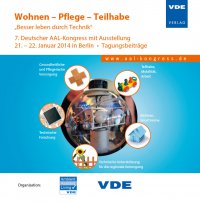Automated Clustering of Home Sensor Networks to Functional Re-gions for the Deduction of Presence Information for Medical Applica-tions
Conference: Wohnen – Pflege – Teilhabe – „Besser leben durch Technik“ - 7. Deutscher AAL-Kongress mit Ausstellung
01/21/2014 - 01/22/2014 at Berlin, Deutschland
Proceedings: Wohnen – Pflege – Teilhabe – „Besser leben durch Technik“
Pages: 7Language: englishTyp: PDF
Personal VDE Members are entitled to a 10% discount on this title
Authors:
Müller, Sebastian; Helmer, Axel; Frenken, Melina (OFFIS – Institute for Information Technology, Escherweg 2, 26121 Oldenburg, Germany)
Steen, Enno-Edzard; Hein, Andreas (School of Medicine and Health Sciences, University of Oldenburg, Ammerländer Heerstraße 114-118, 26129 Oldenburg, Germany)
Abstract:
Automatic health monitoring can help care patients and the elderly population to live safely and independently in their own homes. Sensors detecting human presence and activity, deployed in living spaces, further allow the collection of data useful in assessment instruments such as the Barthel Index and Resident Assessment Instrument. Binary sensors such as passive infrared motion sensors are easy to deploy, low in installation and maintenance costs and collect suffi-cient information for certain assessments while minimizing privacy concerns. However, to date, these systems require preliminary information on the monitored space and placement of sensors, or initialization conducted by professionals. We present a procedure that automates the derivation of room-to-sensor relationships from recorded data, and relaxes the assumptions towards pre-existing information. The approach shows a 95.2% correct clustering of sensors on data col-lected in five households equipped with reed switches, motion and vibration sensors.


